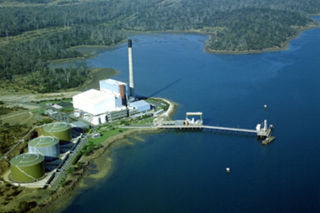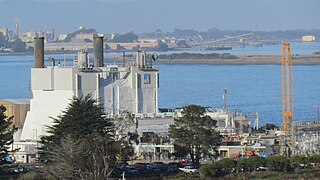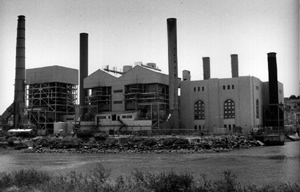
The Pacific Gas and Electric Company (PG&E) is an American investor-owned utility (IOU). The company is headquartered at 300 Lakeside Drive, in Oakland, California. PG&E provides natural gas and electricity to 5.2 million households in the northern two-thirds of California, from Bakersfield and northern Santa Barbara County, almost to the Oregon and Nevada state lines.

A thermal power station, also known as a thermal power plant, is a type of power station in which the heat energy generated from various fuel sources is converted to electrical energy. The combustion or nuclear reaction of the fuel source in a boiler or reactor generates heat, which is converted into mechanical energy using a thermodynamic power cycle, where a working fluid is heated and boiled under immense pressure in a large pressure vessel to produce high-pressure steam. This high pressure-steam is then directed to a turbine through a series of pipes, where the force of the steam rotates the turbine's blades. The rotating turbine, which is mechanically connected to an electric generator, turns the generator's rotor with conductive coils. A stationary magnetic field interacts with rotating coils to produce electricity in them via electromagnetic induction. Fuels such as natural gas or oil can also be burnt directly in gas turbines. These plants can be of the open cycle or the more efficient combined cycle type.

Inverkip power station was an oil-fired power station on the Inverclyde coast, Firth of Clyde, west coast of Scotland. It was closer to Wemyss Bay than Inverkip, and dominated the local area with its 236 m (774 ft) chimney, the third tallest chimney in the UK and Scotland's tallest free-standing structure. In common with other power stations in Scotland it lacked cooling towers; instead, sea water was used as a coolant. The station consisted of three generating units with a combined total rating of 2028 megawatts (MW).

The Moss Landing Power Plant is a natural gas powered electricity generation plant located in Moss Landing, California, United States, at the midpoint of Monterey Bay. Its large stacks are landmarks, visible throughout the Monterey Bay Area. The plant is owned and operated by Houston-based Dynegy and currently has a generation capacity of 1020 MW (net) from its two combined cycle generation units. It was once the largest power plant in the state of California, with a generation capacity of 2560 MW, before its two large supercritical steam units were retired in 2016.

The Bell Bay Power Station was a power station located in Bell Bay, on the Tamar River, Tasmania, Australia, adjacent to the Tamar Valley Power Station, with which it was often confused. It was commissioned between 1971 and 1974 as an oil fired thermal power station, and was converted to natural gas in 2003, after the commissioning of the Tasmanian Gas Pipeline, a submarine gas pipeline which transports natural gas from Longford, Victoria, under Bass Strait, to Bell Bay, Tasmania. As the power station's primary role was to provide system security in the event of drought for Tasmania's predominantly hydro-electric based generation system it only was rarely called on to operate, resulting in intervals of five to eight years between periods of significant use. After the commissioning of Basslink in 2006, the power station was decommissioned in 2009.

Orot Rabin is a power station located on the Mediterranean coast in Hadera, Israel which is owned and operated by the Israel Electric Corporation (IEC). As of 2022 it is Israel’s largest power station and contains six thermal generation units capable of producing a total of 2.59GW of electricity using coal as the primary fuel. In addition, under construction at the site are two single-shaft natural gas-powered combined-cycle units capable of generating 630 MW each. The older, unmodernised four of its total six coal-fuelled units will be closed by mid-2022 in order to eliminate this major source of air pollution in the country.

The Union Pacific GTELs were a series of gas turbine-electric locomotives built by Alco-GE and General Electric between 1952-1961 and operated by Union Pacific from 1952 to 1970.

Zaporizhzhia thermal power station is a large thermal power plant (DRES) in the purpose-built city of Enerhodar in Ukraine. It is the most powerful thermal power station in Ukraine, with an installed capacity of 2,850 MWe. Its primary fuel is coal. It can also fire natural gas and fuel oil, and has tank storage for these reserve fuels adjacent to the coal bunkers.
The Westinghouse Combustion Turbine Systems Division (CTSD), part of Westinghouse Electric Corporation's Westinghouse Power Generation group, was originally located, along with the Steam Turbine Division (STD), in a major industrial manufacturing complex, referred to as the South Philadelphia Works, in Lester, Pennsylvania near to the Philadelphia International Airport.

The Littlebrook Power Station were a series of four oil and coal-fired power stations situated on the south bank of the River Thames, next to the Queen Elizabeth 2 Bridge and the Dartford Tunnel in Dartford, Kent. The final power station, Littlebrook D, ceased operating in March 2015, and has now been demolished.

The New Plymouth Power Station (NPPS) was a 600 MW thermal power station at New Plymouth, New Zealand, that operated from 1974 to 2008. Located at Port Taranaki, it was dual fuelled on natural gas and fuel oil. Constructed at a time of major hydro and HV transmission developments, it was New Zealand's first big thermal power station planned for continuous baseload operation.

The Humboldt Bay Power Plant, Unit 3 was a 63 MWe nuclear boiling water reactor, owned by Pacific Gas and Electric Company that operated from August 1963 to July 1976 just south of Eureka, California.

The Gould Street Generating Station was a former 100 MW electric generating plant operated by Exelon that was located on Gould Street in south Baltimore, Maryland, USA. The plant was adjacent to an elevated section of freeway I-95 and was south of the Riverside neighborhood and west of the Locust Point neighborhood of Baltimore. The plant site, located on the shore of the Middle Branch of the Patapsco River, was used for the generation of electric power for over one hundred years before being shut down on June 1, 2019. The site was purchased by Greenspring Realty Partners, Inc. for $3.1 million in December 2019. Demolition began in October 2020. The original brick buildings, the large storage tanks behind them, and other minor structures on the southwest portion of the property were demolished as of March 2021, but as of April 2022 the larger steel building to the northeast on the property remains. A large portion of the property was acquired by Weller Development in July 2021 and the future of the remaining structure and the property is not known.

The Potrero Generating Station was a natural gas and diesel burning electricity generating station owned by Mirant and located on a 23-acre (9.3 ha) site in Potrero Point, San Francisco, California. The plant's primary power source was a 206 MW, natural gas burning steam turbine providing baseload power and referred to as "Unit 3". In addition, three 52 MW peaking power diesel generators provided additional power during times of highest consumption. Since the closure of the Hunters Point Power Plant in 2006, Potrero was the last remaining fossil fuel power plant within the confines of San Francisco, with capacity to provide approximately 1/3 of the city's peak electrical power needs.

The Tilbury power stations were two thermal power stations on the north bank of the River Thames at Tilbury in Essex. The 360 MW dual coal- and oil-fired Tilbury A Power Station operated from 1956 until 1981 when it was mothballed, prior to demolition in 1999. The 1,428 MW Tilbury B Power Station operated between 1968 and 2013 and was fueled by coal, as well as co-firing with oil and, from 2011, biomass. Tilbury B was demolished in 2016–19. Since 2013 three other power stations have been proposed or constructed in Tilbury.

The Riverside Generating Station is a 261 MW electric generating station operated by Exelon that is located at 4000 Broening Highway in Dundalk, Maryland. The station is on Sollers Point on the Patapsco River.
The Trans Bay Cable is a high-voltage direct current (HVDC) underwater transmission cable interconnection between San Francisco, California and Pittsburg, California. The 53 mi (85 km) cable under San Francisco Bay and through the Carquinez Strait can transmit 400 megawatts of power at a DC voltage of ±200 kV, enough to provide 40% of San Francisco's peak power needs.
The Huntington Beach Energy Project (HBEP), formerly AES Huntington Beach, is a natural gas-fired power station located in Huntington Beach, California.

Gateway Generating Station (GGS), formerly Contra Costa Unit 8 Power Project, is a combined-cycle, natural-gas-fired power station in Contra Costa County, California, which provides power to half a million customers in northern and central California. Gateway Generating Station is on the southern shore of the San Joaquin River, in Antioch, and is one of more than ten fossil-fuel power plants in Contra Costa County.

Potrero Point is an area in San Francisco, California, east of San Francisco's Potrero Hill neighborhood. Potrero Point was an early San Francisco industrial area. The Point started as small natural land feature that extends into Mission Bay of San Francisco Bay. The Point was enlarged by blasted and cuts on the nearby cliffs. The cut material was removed and used to fill two square miles into the San Francisco bay, making hundreds of acres of flat land. The first factories opened at Potrero Point in the 1860s. Early factories were powder magazine plant, the Pacific Rolling Mill Company and small shipyards. The large Union Iron Works and its shipyards were built at the site, stated in 1849 by Peter Donahue. To power the factories and neighborhood coal and gas-powered electricity works were built, later the site became Pacific Gas and Electric Company (PG&E).



















